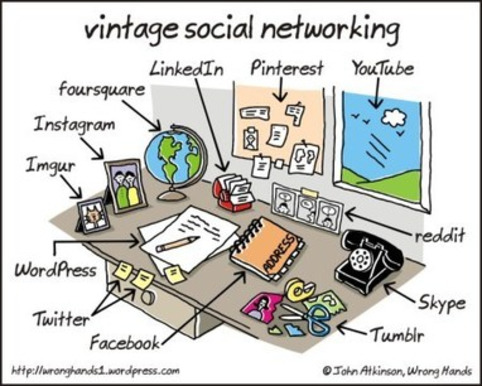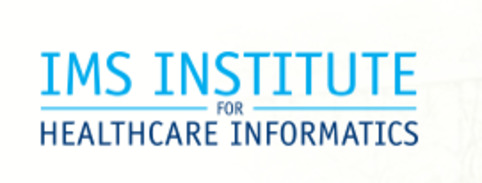 Your new post is loading...

|
Scooped by
rob halkes
February 13, 2014 2:14 AM
|
Corporate Reputation of Pharma 2013 - The Patient Perspective
Press Releas - See here https://www.dropbox.com/s/b8r76li92i89tlx/PATIENTVIEW%20PRESS%20RELEASE%20CORPORATE%20REPUTATION%2013-02-2014.pdf
[Chech the release for more stats!]
A global survey, conducted mid-November to mid-December 2013 Includes the views of 800 patient groups from 43 countries and differing specialtiesPatient-group feedback on the corporate reputation of the pharma industry during 2013Patient-group feedback on the corporate reputation of 33 pharma companies in 2013Results for 2013 are compared with those of 2012, and 2011
This independent study, funded by PatientView, represents 800 patient groups’ latest impressions on the corporate reputation of 33 individual pharma companies and of the pharma industry as a whole. Results for 2013 are compared with those of 2012 and 2011. For the purposes of this report, the phrase ‘corporate reputation’ is defined as the extent to which pharma companies are meeting the expectations of patients and patient groups. The 33 companies examined are: AbbVie l Actavis l Allergan l Amgen l Astellas l AstraZeneca l Baxter International l Bayer l Biogen Idec l Boehringer Ingelheim l Bristol-Myers Squibb l Celgene l Eli Lilly (Lilly) l Gilead Sciences l GlaxoSmithKline (GSK) l Grũnenthal l Janssen l Lundbeck l Menarini l Merck & Co (the US company) l Merck Group (the German company) l Novartis l Novo Nordisk l Pfizer l Roche l Sanofi l Servier l Shire l Stada Arzneimittel l Takeda l Teva l UCB l ViiV
The pharma industry ranks 7th in the league table of 8 healthcare industries, 2013
35.4% of the respondent patient groups stated that multinational pharma companies had either an “excellent” or “good” reputation in 2013, placing pharma 7th in the league table of healthcare industries, below biotech companies, generic drug manufacturers, non-for-profit health insurers, the private healthcare sector, medical- device companies, and retail pharmacists. Pharma, however, has a better reputation than commercial health insurers, which rank last. The reputation of multinational pharma, as perceived by patient groups, was similar in 2013 to its status in 2012. However, the industry’s result is still well below that reported in 2011. 41% of respondent patient groups stated, at the time, that the pharma industry had an “excellent” or “good” reputation in 2011.
Pharma-industry business activities Pharma continues to retain a “good”, or sometimes an “excellent”, reputation for innovation, and for the production of useful products (acknowledged by nearly two thirds, 65%-66%, of patient groups). However, only a minority of patient groups said that the industry was “excellent” or “good” at most of its other business activities in 2013. When comparing 2013’s results with those pharma attained during its high point in 2011, significant shortfalls are apparent. The industry still has a way to go to recover position in three areas of business: relationships with the media, ability to have ethical marketing practices, and acting with integrity.
The performance of individual pharma companies for six indicators of corporate reputation, 2013 Indicator 1: patient centricity At a time when nearly every pharma company is claiming to embrace the patient though new patient-centric strategies, this indicator serves as a useful reminder about just how much progress companies still need to make. Each respondent patient group was asked to name the 3 companies they believed had the best, most- effective patient-centred strategy in 2013.
Indicator 2: high-quality information for patients Each respondent patient group was asked to name 3 companies they believed provided the best patient information in 2013.
Indicator 3: patient safety Each respondent patient group was asked to name the 3 companies they believed had the best record for patient safety in 2013.
Indicator 4: high-quality, useful products Each respondent patient group was asked to name the 3 companies they believed supplied the best, most high-quality products (of most use to patients) in 2013. Indicator 5: transparency Each respondent patient group was asked to name the 3 companies they believed had the best record of transparency with healthcare stakeholders in 2013.
Indicator 6: integrity Each respondent patient group was asked to name the 3 companies they believed had the highest level of integrity in 2013.
The overall performance of individual pharma companies for corporate reputation, 2013 and 2012 Top-10 company rankings for corporate reputation (patient perceptions) Rank in 2013 - ViiV 1st - Gilead 2nd - AbbVie 3rd - Pfizer 4th - Janssen 5th - Roche 6th - Eli Lilly 7th - Menarini 8th - Novartis 9th - Novo Nordisk 10th
Rising stars in 2013 Three other companies stand out as a result of the significant upward shifts they have made in the corporate-reputation rankings. These are the Italy-based Menarini, which jumped from 19th position in 2012 to 8th in 2013 (up 11 slots); France-headquartered Sanofi, which has moved from 23rd position in 2012 to 15th in 2013 (up 8 places); and the Israel-based generics-come-research firm Teva, which also rose 8 spaces (up from 28th in 2012 to 21st in 2013). Although respondent patient groups do not provide The Corporate Reputation survey with the reasons for their selections, it is possible to speculate that Menarini’s success is due (at least in part) to its rapid corporate expansion programme, with extensive acquisitions and partnerships worldwide. Sanofi, in addition to undergoing significant restructuring, has embraced two sizeable biotech firms, and its delivery of new products and a new patient-centric strategy has been interpreted positively by patient groups. Teva has made patient centricity a cornerstone of its gameplan, and, on the whole, patient groups tend to be more favourably disposed to generics companies than to pharma (because the generics business promotes wider access to drugs for patients than pharma).
Press release from PatientView Page 5 of 5 Two further companies with successful corporate reputations are Roche and Eli Lilly. Both inhabit the top-10 positions, and each has moved up two slots since 2012—Roche from 8th to 6th, and Lilly from 9th to 7th. Falling stars in 2013 A number of companies (notably Lundbeck and Novartis) have seen their positions decline. What causes pharma company reputations to rise or fall? The Corporate Reputation of Pharma ‘league tables’ provide feedback on the patient perceptions of each individual pharma company during one particular year. To enable PatientView to turn these patient perceptions into hard, comprehensible figures, large numbers of patient groups need to be included in the study. 800 patient organisations took the time and effort to complete the survey for 2013. As far as is possible to tell, patient groups are influenced by five main factors when balancing up the reputation of a pharma company: 1. A good portfolio of products that brings hope to people suffering from the medical conditions familiar to the patient group. 2. Media coverage about the company (allied to comments received on the ‘grapevine’ from peer patient groups about the behaviour of a corporate). 3. A sense among the patient group that a company is truly putting patients at the heart of its business approach. The company needs to demonstrate this fact, not simply articulate a desire to be patient centric. 4. A perception among the patient group of a year-on-year positive change in the company’s investment stance across the patient arena—whether it is support for specific patient organisations, for big campaigns, or for patient-centred research. 5. A feeling among the patient group that a company’s relationship with it (and with peer patient groups) can be relied upon to be long, rather than short, term. Since the circumstances of individual pharma companies can fluctuate significantly, so, too, can their reputations (as perceived by patient groups). An interesting analogy might be with a company’s share price, which can rise or fall reflecting the market’s perception of the health of the company’s financial future.

|
Scooped by
rob halkes
February 11, 2014 9:13 AM
|
With its use of Twitter, Boehringer Ingelheim has cut a path through the long grass for the rest of the pharmaceutical industry. ..
It is great to therefore see the first business case study from the pharmaceutical industry appear on the Twitter.com website, featuring the work that social media pioneer Boehringer Ingelheim has been doing in using the social media channel to connect with other healthcare stakeholders. The specific case study presented by Twitter is from the #COPDchat tweetchats that Boehringer Ingelheim has been running, but could equally have covered its engaging work in the atrial fibrillation or lung cancer space (which I am proud to have been involved in). ... And the results? Well, the quantitative stats are pretty impressive. 1.7m tweetchat impressions from the hour’s live event, almost 500 mentions of Boehringer at the Congress and 1,200 new followers secured. But the real story here is in the qualitative feedback gained from this tweetchat, and the numerous others Boehringer has run. Through such discussion the company gained valuable feedback on the market, which was spur-of-the-moment and reactive to developments at the Congress itself, in addition to opening doors with new organisations and individuals that can help its mission in the COPD space. Twitter identified three key lessons from Boehringer’s work on tweetchats for other pharmaceutical companies: - Align such online discussion with relevant offline events, like the Congress.
- Involve key internal stakeholders to ensure regulatory compliance.
- Be innovative – don’t be afraid to be the first in your sector rather than waiting for others.
With such prominence, quite rightly so, being given to Boehringer’s work it is time for other pharma companies to step up and also start driving such activities. Every pharma company is talking about being customer- and patient-focussed, and indeed the individuals working within these companies are passionate about making a difference, so communications teams need to start facilitating more of this work.

|
Scooped by
rob halkes
February 11, 2014 4:07 AM
|
As the Affordable Care Act rolls out, the behaviorists at MicroMass surveyed stakeholders about the impact on industry. Jessica Brueggeman sorts out the diverse views and asks Can healthcare reform lead pharma to operationalize its patient focus
Patient centricity. Real-world value. Patient-reported outcomes. These phrases have become a fixture in today's healthcare environment, thanks to the Affordable Care Act. But what do these concepts mean and how are they affecting the way key healthcare stakeholders think and work every day? To gather a diverse and comprehensive perspective on the impact of healthcare reform on pharma, MicroMass conducted a qualitative research study, speaking with 21 individual healthcare stakeholders, including patients, physicians, practice managers, hospital administrators, marketers, payers and allied healthcare professionals. The findings highlight a way for pharma to set an industry standard by defining and operationalizing the concept of patient centricity...
New measures of success Healthcare reform sparks polarizing views among stakeholders... Amid these views, a commonality is the belief that patient-centricity will yield success. The challenge is in how that is defined. For patients, success centers around a positive experience with staff and providers, being included in treatment decisions and having questions answered. Providers gauge success based on their ability to provide quality care, although definitions of “quality” vary among clinical outcomes, patient satisfaction and practice success/business metrics. The lack of clarity presents an opportunity for pharma. Unless pharma better aligns itself with patient and provider definitions of success, however, its commercial success could be in jeopardy. Pharma cannot passively stand by, observing the impact of change. Nor should it expect guidance from non-industry organizations on its role in a value-based environment. ..
The path to patient-centricity
1. Leverage partnerships to establish a consensus definition of patient-centricity .. 2. Re-think the current business model .. ... 3. Deliver value-based solutions (some examples) ...
What does it take for pharma to make these leaps? First, we have to set aside the traditional playbook and wait for long-term benefits, to take risks, and to be agile and try new things. Then we have to put aside the desire for complete ownership and engage in true collaboration to share authorship of impactful solutions.
The time is now. Change isn't on the way, it's here...

|
Scooped by
rob halkes
February 3, 2014 1:24 PM
|
Has tipping point for social media in pharma finally arrived? By Rio Longacre and David Mun, with special thanks to Timothy Moore. It’s no big secret the pharmaceutical industry lags way behind other sectors when it comes to leveraging social media to meet business objectives. A big reason for this has long been a lack of clear guidelines from FDA. This month FDA released its draft guidance on the use of “Interactive Promotional Media,” ending several years of speculation and finally providing the industry with substantial guidance on its use of digital media. Though this draft guidance document is currently being distributed for comment purposes only, for the first time it sets out a clear position on tools and technologies that allow for real-time communications and interactions, which includes social media. In the new guidelines, FDA explains that pharma firms should identify the parts of websites that are interactive and allow for real-time communications, in addition describing its communications within these third-party sites. On a monthly basis, marketers will also need to submit a Form FDA 2253 or Form FDA 2301 for websites that include interactive or real-time communications. To facilitate the submission process, FDA will allow multiple sites and the corresponding documents within a single form — a stark departure from its policies governing static promotional pieces. ... Many feel this recent news will mean the proverbial tipping point has been reached, and pharma will finally take the plunge in social media. If so it will certainly be about time, as social media has become pervasive in our lives and, let’s face it, pharma is coming more than fashionably late to this party. According to a recent Pew Internet study, as of September of last year 73% of online adults use social networking sites. As of 2012, close to three-quarters of Fortune 500 companies were active on Twitter, with more than 80% of executives at these firms believing social media engagement actually led to increased sales. Across industries, an astounding 93% of marketers report they use social media for business. Despite years of exposure and ample case studies of success from other sectors, however, most pharma companies don’t currently have much of a social media strategy and the vast majority enjoys a rudimentary presence at best. To drive home this fact, in a recent survey more than 90% of 88 executives representing Big Pharma firms said “no” when asked: Does your company engage potential or current customers via social media? By and large, pharma companies have been extremely conservative in their approach to social media. In addition to a lack of clear guidelines, many firms have kept the medium at arm’s length due mainly compliance concerns related to Adverse Event reporting and potential off-label discussion between reps and patients taking place in a public forum... While this strategy may have kept stakeholders in compliance happy, generally speaking it has been extremely short-sighted and resulted in significant missed opportunities for the industry in terms of branding and generating goodwill with its customers. If anything, it has helped fuel the perception of an industry more concerned with protecting itself from liability than responding to the needs and concerns of its customers. On the face of it, pharma is not alone in being heavily regulated. ... Relative to the US, in the EU pharma companies, in collaboration with regulators, are making greater efforts to leverage social media to monitor adverse events. More specifically, the Innovative Medicines Initiative (IMI) has been created in the aim to build electronic reporting platforms and mobile apps to enable patient reporting of adverse events to regulatory authorities themselves. One can certainly speculate whether these practices will make their way over the Atlantic. When reviewed in its entirety, it’s not difficult to conclude that compliance issues alone fail to explain fully pharma’s disdain for the medium. If nothing else, a significant reason for the industry’s hands-off approach most likely stems from pervasive skepticism of the channel’s overall benefit for an industry that generally does not usually have direct relationships with its end-customers. In light of evolving consumer preferences, this argument looks increasingly silly and out of date. Pharma must accept the fact the relationship it enjoys with its customers doesn’t take place in a vacuum. Its customers are also customers of firms in other industries, and consequently bring a high level of service expectations based on these other non-pharma interactions. In terms of providing a positive and rewarding customer experience, pharma is now competing with these brands and must attempt to live up to the lofty standards they set. And let’s face it, consumers are talking about pharma companies whether they are using social media or not. And believe it or not, pharma’s customers actually want pharma to play a bigger role in social media-sphere. As proof, Manhattan Research recently reported that 42% of online consumers think pharma companies should be involved in online health communities. Now that social media guidelines are falling into place, in coming months we can probably expect to see a growing shift in mentality across the industry as firms recalibrate their marketing strategy to include a social component. Due to heavy regulations and ever-present compliance concerns, of course, jumping on the social media bandwagon will still require a measured and deliberate approach. But it will require an approach nevertheless...!

|
Scooped by
rob halkes
February 3, 2014 10:12 AM
|
IMS's Top 10 Pharma Social Media Engagers By Ben Comer | Published: January 21, 2014 The IMS Institute for Healthcare Informatics worked up a methodology for assessing the effectiveness of pharma’s social media efforts across Facebook, Twitter and YouTube, according to three indices: reach (total number of people reached through each channel via likes, shares and re-tweets); relevance (extent to which content is being shared and forwarded); and relationship (amount of back and forth between company and patient). Those pharmas hitting the trifecta scored best on the cumulative “Social Media Engagement Index.” Results were tallied over a two-year period. Here are the top ten pharma engagers, per IMS Health. To read the full report, which discusses the role of Wikipedia, healthcare professionals’ use of social media, and a summary of social media regulatory policy in the US, Canada and the EU, click here. And the winners are: IMS Health Social Engagement Index 1. Johnson & Johnson 2. GlaxoSmithKline 3.Novo Nordisk 4. Pfizer 5. Novartis 6. Boehringer Ingelheim 7. Bayer 8. Merck 9. AstraZeneca 10. UCB In a separate article, consultants at Capgemini Consulting Life Sciences wonder if social media in pharma has reached a tipping point. PharmExec’s sibling company, CBI, is hosting its annual iPharma conference in New York City this May.

|
Scooped by
rob halkes
January 31, 2014 4:22 AM
|
Chooses Yale to act as independent trial data request review body

|
Scooped by
rob halkes
January 31, 2014 4:19 AM
|
GPs in the UK rate journals, educational materials and events over literature, websites and reps from pharmaceutical companies when it comes to communicating information, according to the 2013 National Medical Readership Survey (MRS). .. The survey was intended to determine GPs' attitude to, and use of, print and digital media when it came to their work, with key findings including that speed is of the essence, with online sources increasingly the first port of call for quickly checking clinical information. Other key values of online for GPs included the ability to look for specific information. Printed publications still have their place, however, with the survey discovering that GPs value print read for 'longer, serendipitous and more leisurely reading', as well as to keep up-to-date with developments in clinical practice and for ongoing professional education. Regarding the medium for information, the survey found that GPs consider search engines the most useful source, following by medical educational materials. Social media for GPs was considered second least useful, ahead of pharmaceutical company and product websites. The survey also set to find out GP behaviour when it came to the types of information they look at, regardless of the medium. The top five information areas were those which fulfil surgery information needs: clinical information on diseases and conditions; information on drugs/treatments and prescribing; clinical guidelines; local protocols; and patient information. The 2013 survey included – for the first time – an online element. Combined with the established postal survey, this provided extensive data on the 'media landscape' as used by GPs, and the survey now delivers data on print readership, digital edition/ app usage and website usage.

|
Scooped by
rob halkes
January 28, 2014 8:00 AM
|
t's taken a while for our industry to get on board, but it appears that tablet detailing has finally arrived. One in three details is conducted via an iPad or similar device, according to Hall & Partners research, and of our clients that have yet to embrace this evolution most say they plan to do so soon. .. However, how much thought are we giving to this new technology? Often we hear that the edict has come from 'on high' … “We are going digital!” our clients tell us. But when we sit down to consider what this really means, conversations are often focused on the format and execution, rather than the potential for interaction offered by the new detailing medium. This approach sells tablet detailing short. Tablet details are visually appealing and novel, they hold vast amounts of data and offer the potential for animation and video. All good stuff, but they also provide the perfect tool to deepen customer relationships. .. we often see that the approach to sales interactions via tablet detailing hasn't kept pace with this new reality. In 2014 we should be looking to change this.
Meeting customer expectations
Our research shows that customers have increased expectations of a tablet detail - associating the medium with innovation and interactivity. However, customer experiences of tablet detailing reveal it is perceived to offer no benefit over paper-based detailing in eliciting interest in the brand or encouraging follow-up with the rep. Pharmaceutical industry marketers and communications agencies tell a similar story of paper-based details all too often simply converted to tablet format, overlooking the opportunity the tablet provides to allow us to achieve so much more in our customer interactions... So far we are only scratching the surface of what tablets offer in building a more holistic picture of our customers....

|
Scooped by
rob halkes
January 23, 2014 11:09 AM
|
Objective This study explored patient recall of clinician presentation of information about prescription medication, looking specifically for communication patterns and differences by patient individual characteristics and by medication availability type. Methods A cross sectional survey collected information about 216 patients’ perceptions of clinician presentations of medication information. Results Demographically, males recalled receiving more information about reasons, risks, and regimen in medication discussions. By medication type, patients reported receiving more medication information when the clinician presented a prescription-only medication as opposed to a medication that was also available over the counter. Conclusion Given the broad and unmonitored use of over-the-counter products, coupled with the increasing awareness of risks associated with many of these medications, it is concerning that patients report receiving less information about these products. Practice implications The emphasis on appropriate medication counseling should not be limited to medications available only by prescription. Prescribers should be mindful of these potential tendencies when discussing medications.

|
Scooped by
rob halkes
January 22, 2014 5:00 AM
|
A perspective on the big trends that are changing pharmaceutical sales and the new best practices and opportunities those trends inspire. At the Health Experience Project, we believe the right experience can change everything. Every day, the Health Experience Project explores the experiences that are changing outcomes for people, for professionals, and for brands. In this report, we’ve curated some of our most important findings from the frontlines. Inside, you’ll find the big trends that are changing pharmaceutical sales and the new best practices and opportunities those trends are inspiring.
Designing the Pharma Rep Experience for 2015 brings together research from the Health Experience Project, GSW, and other experts across our industry. SECONDARY RESEARCH FROM: Manhattan Research, ZS Associates, PwC, Booz Allen Hamilton, Accenture, Hay Group, INSEAD, IBM, Deloitte Special thanks to our core contributors: Alex Brock, Bill Robinson, Dawn Marinacci, Joy Hart, Kevin Coleman, Leigh Householder, Matt Cash, Michael Krohn, Nick Bartlett, Ritesh Patel, Ryan Deshazer, Tyler Durbin HANDS ON EXPERIENCES WITH: RepLab: Exclusive think tank that brings together field reps from our contract sales team with iQ, our product development lab Rep rides: Accumulated experience from over 100 rep rides around the world Global digital collaborative: 62 specialists from across our global network committed to innovation

|
Scooped by
rob halkes
January 20, 2014 7:08 AM
|
The Latest News and Stories Related to the IMS Institute Growth Expected to Accelerate from Low Point in 2013
To 5-7 Percent in 2017; Rising Number of Innovative New Drugs Expected
To be Approved Over Next Five Years
PARSIPPANY, NJ, November 19, 2013 – Greater access to medicines by the world’s rapidly expanding middle class, together with stronger economic prospects in developed nations, will bring total spending on medicines to the $1 trillion threshold in 2014 and to $1.2 trillion by 2017, according to new research released today by the IMS Institute for Healthcare Informatics.
The report, The Global Use of Medicines: Outlook through 2017, found that growth in global spending on medicines increased 2.6 percent to $965 billion in 2012, and is forecast to grow at a 3-6 percent compound annual rate over the next five years. With new product launches dominated by innovative specialty medicines, particularly for the treatment of cancer, payer concerns about rising costs for these drugs will intensify in both developed and pharmerging markets. Spending on specialty medicines is expected to reach $230-240 billion in 2017, up 38 percent from the $171 billion spent in 2012.
“As we pass the fifth anniversary of the global economic slowdown, and with many countries moving toward universal health coverage, we expect to see continued divergence in growth rates between the pharmerging and developed markets,” said Murray Aitken, executive director of the IMS Institute for Healthcare Informatics. “Austerity measures aimed at medicine budgets along with the growing availability of lower-cost generics will lead to annual spending growth of 1-4 percent among the markets of North America, Europe and Japan. In contrast, pharmerging nations will experience 10-13 percent spending growth overall – the result of economic expansion, changes in epidemiology and demographics, and greater government and private insurance funding for healthcare.”
In its latest report, the IMS Institute highlights the following findings:
- Structural changes within healthcare systems globally are creating divergent trends ...
- A gradual increase in global medicine spending growth will unfold during the next five years, but remain at modest levels ..
- Specialty and biologic segments of branded medicines will outpace overall spending growth ..
- An average of 35 new medicines with the potential to transform disease treatments is forecast to be launched annually ..

|
Scooped by
rob halkes
January 16, 2014 5:33 AM
|
Why clinical trials need mobile health tools
mHealthNews (blog)
Pfizer used social media to recruit patients for a clinical trial of Detrol. .. CROs (clinical research organization, "an organization that provides support to the pharmaceutical and biotechnology industries in the form of research services outsourced on a contract basis") as we know them today started in the late 1970s and early 1980s and have grown as a part of Pharma R&D budgets from 4 percent in the 1990s to close to 50 percent in the mid 2000s. In a previous post on why Pharma needs mobile apps, I briefly mention their potential role in clinical trials. I would like to discuss this in more detail now. The cost of performing clinical trials is increasing significantly. Technology including mobile technology and analytics can decrease these costs, but the challenge is for both business models and the research processes to adapt around them. This presupposes that the technologies can perform trials well. .. Both the European Medicines Agency and the FDA have endorsed centralized monitoring of trials via technology on a real-time basis. .. Recruitment of patients is another aspect of digital technology in clinical trials. Pfizer used social media to recruit patients for a clinical trial of Detrol. One company hosting 200,000 patients in online communities which gather data on 150,000 disease states, PatientsLikeMe has signed agreements with pharmaceutical companies to match patients with trials using its clinical trial search tool. Other advantages of mobile clinical trials, as I see them, include less biased recruitment via crowdsourcing, a dramatic reduction in costs, better medication tracking via pill sensor technology (Proteus Digital Health), and faster reporting of adverse events (which can potentially save lives and stop negative studies earlier via transmission to the Data Safety Monitoring Board), and more timely analytics and trial reporting. In addition, they might lend themselves to more comprehensive or efficient audits, and will strengthen the assistance of caregivers (who can receive and transmit data with/for the patient) in the trial. .. While I do not believe that mobile technology will replace CROs, I do believe that it will significantly reduce costs and improve procedural inefficiencies and accuracy. The digitalization of clinical trial data represented a significant step in improving process and quality of trials. Making it mobile will take it to an even higher level. David Lee Scher, MD, FACP, FACC, FHRS, is a clinical associate professor of medicine at the Pennsylvania State University College of Medicine,

|
Scooped by
rob halkes
January 14, 2014 7:46 AM
|
Last year, we released a lot of the presentations that were delivered at the BioPharma Asia Convention 2013 and they sparked off numerous conversations, discussions, debates and have given us lots of ideas for topics and themes to raise at this this years event. Click here to download this ebook > This ebook features presentations on: Pharma Supply ChainDrug DiscoveryClinical TrialsBiologic ManufacturingPharma Partnering & InvestmentAsian Biotech Companies

|
Scooped by
rob halkes
January 14, 2014 7:36 AM
|
The FDA's just-released draft social media guidance has been more than four years in the making but finally looks to offer industry some substantial direction on its use of digital media. Given that the US regulator's November 2009 hearing on “using the internet and social media tools” encompassed such burning digital issues of yesteryear as Google Sidewiki, it's fair to say the guidance wasn't exactly rushed through. Following up on that hearing the FDA yesterday set out its position on 'interactive promotional media', that is “tools and technologies that often allow for real-time communications and interactions”. These tools and technologies, it explains, include blogs, microblogs social networking sites, online communities, live podcasts, which pharma uses to promote its drugs. ... Its guidance notes that “although some interactive promotional media are substantially similar in presentation and content to certain traditional promotional media, such as print media, FDA recognises that in other cases they possess certain unique technological features and offer novel presentation and content features”. In terms of what it covers, the FDA said it will only examine product communications that use interactive technologies which are subject to “substantive influence by firms that market the product, therefore triggering post-marketing submission requirements”. (headlines only now from original texts, See all at PMLIVE blog) The FDA's social media recommendations • Firms are responsible for product promotional communications on sites that are owned, controlled, created, influenced, or operated by, or on behalf of, the firm; • Under certain circumstances, firms are responsible for promotion on third-party sites;
• A firm is responsible for the content generated by an employee or agent who is acting on behalf of the firm to promote the firm's product; The regulator also said it wanted to receive all user-generated contact (UGC) that falls within its recommendations for interactive promotional media. But the guidance does acknowledge the need for a practical process that addresses “the potential volume of real-time information that is continuously posted and shared through various interactive promotional media platforms”. Consequently it suggests that, once a month, companies should submit an updated listing of all non-restricted (non-password protected) sites for which it is responsible, or in which it remains an active participant, and that include interactive or real-time communications. Once finalised the guidance will represent the FDA's current thinking on fulfilling the regulatory requirements for post-marketing submissions of interactive promotional media for drugs. It will then add to a growing body of digital guidance from the FDA that so far covers off-label information on social media and a tailored approach to mobile app regulation.

|
Scooped by
rob halkes
November 8, 2013 10:43 AM
|
This morning, I read with interest "The Value of Social Media Listening" by Alexandra Fulford, a ZS Business Consultant based in Zurich, Switzerland,
Alex focused on the "value in listening and doing research to identify the following elements" I soon realized, however that something was missing.
Most, if not all, of the value emphasized by Alex was the value for the pharmaceutical company (listener), not for patients, which I assume are the "listenees" in this case.
No doubt that collecting the sort of data Alex recommends will help pharma companies "develop more impactful messaging and marketing tactics," as Alex points out. It will also help them "engage with stakeholders" and "improve Search Engine Optimisation," which are all benefits accruable to the listener, not the listenee.

|
Scooped by
rob halkes
November 8, 2013 10:35 AM
|
An improperly implemented patient-facing healthcare program may ultimately damage the relationship between pharma and patients. Cutting Edge Information's Elio Evangllista shares his tips on how companies can fully (and successfully) embrace the...

|
Scooped by
rob halkes
November 8, 2013 6:44 AM
|
In this post, using the topic of chronic obstructive pulmonary disease (COPD) as an example, Marie-Claire Wilson outlines some of the most commonly-seen behaviours of HCPs online, giving an insight...

|
Scooped by
rob halkes
November 8, 2013 5:40 AM
|
As the health service grapples with the need to provide quality care while containing spiralling patient care costs (something all stakeholders will need to do for decades to come), the ability to manage care in a holistic, safe and cost effective way is a priority for commissioners. Choosing the best healthcare partner to deliver these often complex and detailed healthcare requirements is high on the agenda for many commissioners and with the recent changes to NHS commissioning and the publication of the Homecare Medicines Review guidelines, this task has become even more important to get right first time round. So what can you do to ensure the right partnerships are formed that best meet your individual service objective needs? First of all, the healthcare partner should offer a broad and integrated range of services such as medicines distribution/logistics, clinical homecare, medicines support, dispensing services, medicine preparation and clinical trial support. Not only does provision of these cohesive services avoid the need for other external partners and contracts, but it also creates the flexibility to add-on future services as end-to-end patient healthcare needs develop and expand. In addition, this fully integrated approach has a greater potential to lead to service efficiencies, flexible service delivery and improved patient care. .. The healthcare partner must help patients make better use of the medicines and therapies they are prescribed and by doing so, the NHS can be supported to deliver the demands of the Government's QIPP (Quality, Innovation, Productivity and Prevention) agenda .. .. Most importantly, a partner should be able to demonstrate a strong track record of patient-centric care that supports patients throughout their care journey... An aspect which is perhaps given less weight is the existence of shared values and complementary multi-disciplinary expertise between stakeholder organisations. In my opinion, evidence of this is critical to engender mutual trust and respect between both organisations, as no doubt the ability for co-operative working will be tested under the current challenging and changing healthcare environment. Ultimately, the true measure of success will be the strength of the relationship between the healthcare provider and partner as they work together in the pursuit of mutual goals to deliver the best possible care for their patients.

|
Scooped by
rob halkes
November 8, 2013 5:27 AM
|
After almost two years of negotiations, the UK Government and pharma industry have agreed a revision to the system for drug pricing of branded medicines in England to commence from January 1, 2014. One of the main points of the note in the new Pharmaceutical Price Regulation Scheme (PPRS) is a price freeze on NHS medicine expenditure in England over the next two years in order for the service to help claw back part of the £12bn annual drug budget amid wider cost-cutting measures. This comes despite previous growth forecasts in NHS medicine spend of 3.87 per cent and 3.52 per cent for 2014 and 2015 respectively, meaning that pharma companies effectively have to face a price cut on branded medicines to stick to the revised budget. Prices will then be allowed to increase over the next three years, although at a rate less than previously forecast. The agreement, which was negotiated between the Department of Health (DH) and the Association of the British Pharmaceutical Industry (ABPI), also clarified that pricing assessment for new drugs could take into account the wider value of a medicine. rom 2014, the National Institute for Health and Care Excellence (NICE), which assesses the cost-effectiveness of drugs for NHS use, may perform an appraisal of a new medicine that takes into account its wider societal value if requested to do so by the manufacturer.

|
Scooped by
rob halkes
November 8, 2013 5:12 AM
|
Pharmaceutical industry is complex more than ever. It needs to accurately identify its true target clients and the buying criteria. Pharma companies also needs to figure out the best ways to get messages out to more prospects. Traditional methods may not produce much-needed results. Thus, industry leaders require new tools to use to read the market correctly and develop the right responses to it. One significant instrument that they use is Topo.ly online mapping. It is a mapping solutions provider that makes data analysis easier as the users create a map. This method is simpler but more appropriate to achieve market effectiveness faster.
- How Mapping Helps Pharmaceutical Industry Face New Challenges .. - Define and reach target audiences.. - Select targets .. - Recognize power players and influencers .. - Send right messages in the right ways .. - Develop marketing channels and touch points
. ..

|
Scooped by
rob halkes
November 4, 2013 2:02 PM
|
A clear majority of both patients with chronic diseases and the health professionals who treat them are in favour of the remote monitoring of patients’ conditions, according to the first ever study in Spain of the practice conducted by the IESE...

|
Scooped by
rob halkes
October 22, 2013 5:53 AM
|
The UK government's plans to introduce a new system of drug pricing that takes into account the wider value of a new medicine is neither in the patient interest nor national interest, according to a leading healthcare think-tank. 2020health said it approached the subject from the patient's perspective and concluded that the current PPRS system for drug reimbursement has kept UK medicine prices below the average in advanced countries and also supported R&D. However, if the government goes ahead with a planned 2014 switch to value-based pricing (VBP) – which would take into account wider societal benefit, extended cost savings and the medical value of a drug to different patients – it could harm both access to drugs in the UK and the country's research environment... .. Its other recommended changes to the current pricing system include lowering the price of older drugs so that companies are given the leeway to sell new medicines at a higher price, while bonuses should be offered to companies marketing drugs for less common conditions. Go to the site of PMlive to collect the report!

|
Scooped by
rob halkes
October 16, 2013 10:40 AM
|
Dont be fooled by flat spendbig changes are happening. James Chase offers key insights from an exciting new study.. There's no question that the healthcare sector is in transition. For the past few years, a well-documented “perfect storm” of converging pressures of trends and events—such as the patent cliff, regulatory scrutiny, pipeline issues, healthcare reform, digital evolution, patient empowerment, the economy—has pounded the industry with maximum force. And drug manufacturers are bearing the brunt. “The era of Big Pharma, and marketing the magic of a pill, is gone,” says Kate Cronin, global managing director at Ogilvy CommonHealth PR. “Now it's about everything that surrounds a pill, including services, disease awareness, education and prevention.”.. As a result, companies have been forced into changing the way they develop products, the way they do business and the way they interact with customers. These changes are already manifesting themselves into the marketing functions, as companies begin shifting priorities, retooling resources and reallocating investment between brands, channels, tactics and audiences... The results reveal that while overall marketing budgets remain fairly flat this year, there has been significant movement between the tactical buckets—namely an increase in digital spend at the expense of some of the more traditional channels. There is also evidence of some withdrawal from unbranded communication. In terms of their biggest challenges, marketers are concerned about the effects of FDA regulations and pressure from payers, while looking ahead they overwhelmingly agree that the industry has to transform itself in order to remain viable and competitive.... Finally, respondents were asked to rate how strongly they agreed or disagreed with various statements pertaining to the future of the industry. At the top of the pile 86% agreed or strongly agreed that “The healthcare industry will need to change its business model to remain viable in the future”. Other popular statements included, “Digital media has forever changed the way the healthcare industry needs to communicate and engage with its constituents” and “The healthcare industry will quickly need to become more nimble to remain competitive in the current business landscape.”

|
Scooped by
rob halkes
October 16, 2013 5:38 AM
|
Generics pack the same punch as brand-name drugs, for less. So why can’t they get more respect? By Katie Thomas. [ Read the fiull blog ! This is just a summary of excerpts! ] .. It’s been nearly 30 years since Congress kick-started the generic drug industry by passing the Hatch-Waxman Act, the 1984 law that made it easier for pharmaceutical companies to sell copycat pills as long as they could prove the drugs were identical to the brand-name versions. Today, the Food and Drug Administration and nearly every other major health authority agree that generic drugs are safe and effective... The reason, from a public health perspective, is clear: Many generic drugs cost pennies per pill, yet pack the same punch as brand-name medicines. So why can’t they get more respect? Television writers aren’t the only ones who suspect that generic drugs are somehow subpar. In 2007, researchers at Brigham and Women’s Hospital in Boston surveyed more than 1,000 patients about their views on generic drugs. Participants agreed overwhelmingly that generics were “a better value” than branded drugs, and fewer than 10 percent believed that generic drugs caused more side effects. More than half expressed the opinion that Americans should be taking more of them. But when it came to the patients themselves, only about 38 percent said they preferred generics over brand-name drugs. .. Some studies have found that lower-income patients — those who could benefit the most from generics — are among the groups that are most skeptical... Intrigued, the researchers set out to discover why. In an article published in 2012 in the journal Preventing Chronic Disease, patients gave some reasons that seemed straightforward: brand-name drugs were perceived as being of higher quality, or of causing fewer side effects. But other explanations were more complex. Some of the patients said they felt forced to “settle” for lesser drugs because they were poor and black... Skepticism about generic drugs is not limited to the poor and disadvantaged, however. One recent study found that almost 50 percent of doctors held negative views of the quality of generic medications, and more than a quarter said they would rather not use generics for either themselves or their families... Generic drug makers haven’t been doing themselves any favors recently... SOME have said that the rapid expansion of the generic drug industry over the past decade — and the influx of drugs from overseas companies in countries like India — has compromised quality... Over the past decade, health insurers, large employers and major health care providers have led the switch to generic drugs because they cost so much less — often about 80 percent less than the brand-name drug. Patients in most private health plans must use generic drugs or pay higher co-payments, and drug-benefit managers have perfected the art of converting patients from a brand to a generic as soon as a drug loses its patent protection. Those efforts have paid off: spending on drugs actually decreased by 1 percent in 2012, the first decline since the research firm IMS Health first began tracking such numbers in 1957.. .. What does this mean for consumers? Despite lingering mistrust, the debate over generic drugs has largely ended — we’re all inmates in that fictional women’s prison. And most experts would agree there’s probably nothing wrong with that.

|
Scooped by
rob halkes
October 11, 2013 1:15 PM
|
No one would disagree with the premise that social media has changed how we communicate, but when it comes to the discussion of how best to use social channels, there is still disagreement around the extent to which brands should focus on placing content or planning for organic discovery. With the emergence of social media came an evolution of the paradigm for digital content discovery: the primacy of search to deliver trusted, timely and valuable information has now been displaced by sharing. And here lies the importance of serendipity. With our social feeds acting as a vehicle for the accidental, but delightful, discovery of something useful, we find content that we didn't even know we were looking for. .. Real discoveries of serendipitous content can be thought of as 'happy accidents'. For the pharmaceutical industry, that can sound worryingly synonymous with 'unsolicited', but this simply highlights that the power of social for pharma lies within disease awareness. As digital pharma teams, we spend a lot of time placing our content exactly where people go looking for it – the familiar truism of 'fishing where the fish are'. But this isn't really enough. If social is to deliver on its potential for serendipity, pharma teams need to do more than sit back, relax and hope that their audiences visit the Facebook page their agency sold them – they need to provide the prompts that are so necessary to encourage voluntary sharing. This is achievable by focusing on three key things: 1. Understanding behaviour;... 2. Understanding audience personas and journeys ... 3. Actually adding value.. (!) .. f you are still wondering where your social efforts are best placed, turn your attention away from Facebook.. ... Understanding preference, behaviour and personas, which is serendipity at its best.
|




 Your new post is loading...
Your new post is loading...
































Grand developments in Pharma's reputattion among patients!
Needed Information! Check it